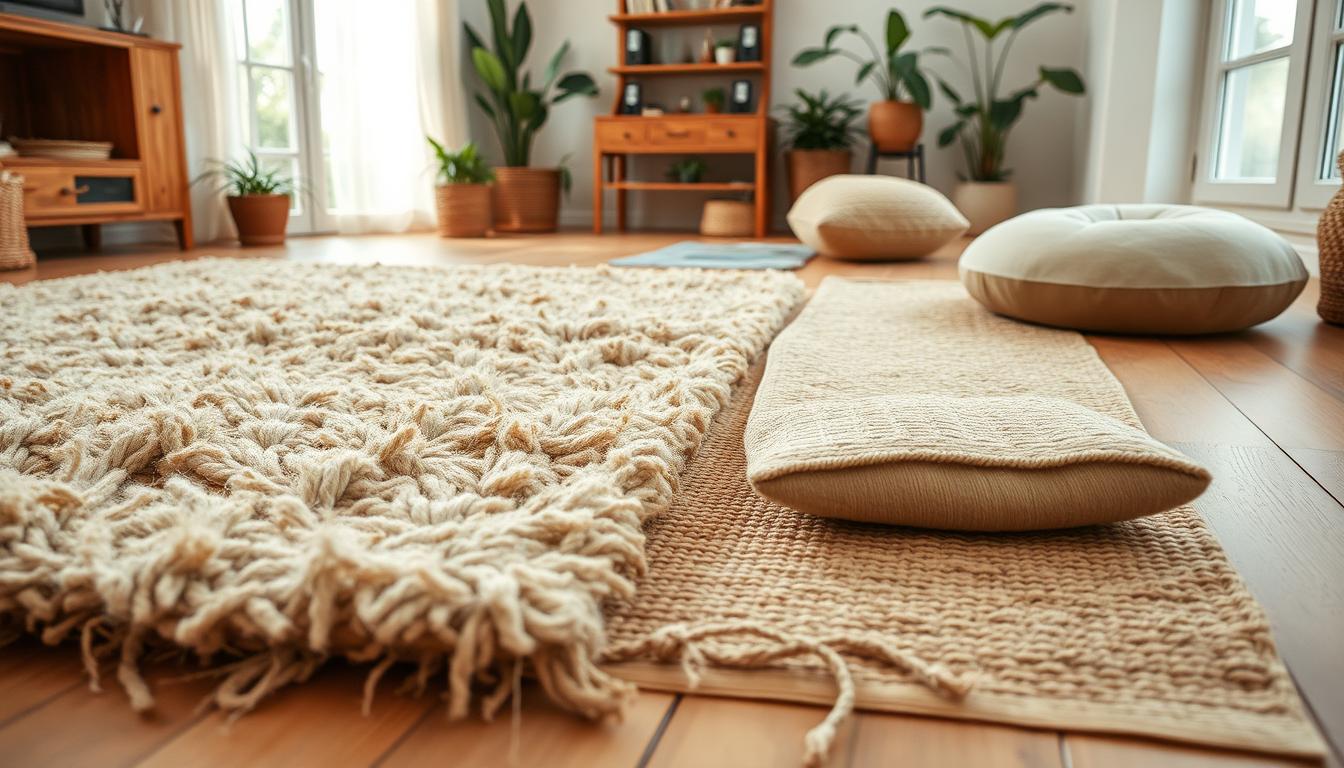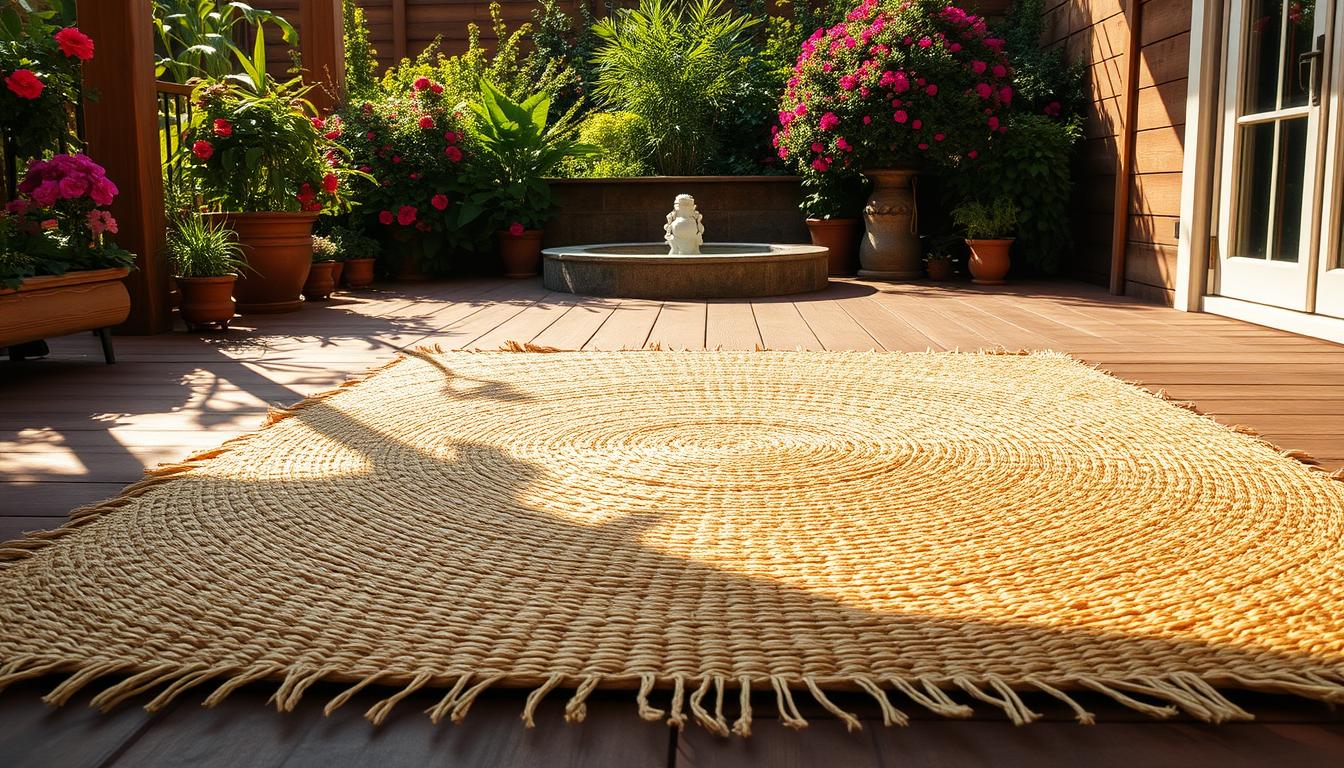
6 Chic Sisal Rug Layering Ideas for Natural Style
What if your floors could visually expand your space while making every room feel intentional and inviting? In an era where minimalist flooring dominates, designers are rediscovering how strategic layering creates warmth and dimension that bare floors simply can’t match.

This approach goes beyond aesthetics. When done right, layered floor coverings solve practical challenges like defining zones in open-concept homes or softening footsteps in high-traffic areas. Our guide reveals how natural fiber rugs serve as the perfect foundation for building depth through contrasting textures and proportional pairings.
You’ll learn to balance organic materials with bold patterns, creating focal points that draw eyes to your favorite furniture arrangements. We’ll show how these techniques help small rooms feel airy while adding cozy sophistication to expansive spaces – all without compromising durability or comfort.
Key Takeaways
- Layering transforms empty floors into dynamic design elements that define spaces
- Natural fibers create sustainable foundations for mix-and-match combinations
- Proper proportions ensure layered looks feel cohesive, not cluttered
- Texture contrasts add tactile interest while softening high-traffic zones
- Strategic placement enhances room flow and visual proportions
Understanding the Essentials of Rug Layering
Imagine walking into a room where every step feels intentional yet effortlessly inviting. This effect comes from mastering the art of combining floor coverings – a technique that turns blank floors into curated design statements. Unlike single-piece solutions, strategic combinations create dimensional harmony while solving common spatial challenges.
Why Layer for Organic Appeal?
Mixing materials adds depth to open areas that feel too expansive. Rough-weave fibers paired with soft textiles create tactile contrast, making rooms feel lived-in yet polished. This method lets you repurpose smaller pieces that might otherwise gather dust – think rectangular runners under circular accents.
Texture Meets Color Theory
Earth-toned foundations allow bold patterns to shine without visual chaos. Neutral bases ground vibrant accents, letting you experiment safely with trending hues. The table below shows winning combinations:
| Base Texture | Top Layer | Visual Impact |
|---|---|---|
| Coarse weave | Geometric print | Modern rustic |
| Tight knit | Faded vintage | Coastal charm |
| Herringbone | Solid shag | Urban oasis |
Seasonal updates become simple – swap lightweight cotton layers for chunky knits when temperatures drop. For lasting durability, consider natural fiber foundations that withstand years of style changes.
Selecting the Perfect Base Rug
What transforms a room from flat to fascinating? The answer lies beneath your feet. Your foundational layer sets the stage for every design choice that follows, acting as both anchor and amplifier for your space’s personality.

Why Natural Fibers Work Best
Jute emerges as the MVP of base layers. Its earthy texture adds depth without competing with other elements, while neutral tones create a blank canvas for bold accents. These materials withstand daily wear while softening footsteps – crucial for busy households.
Consider this: A 2023 interior design survey revealed 68% of designers prefer natural fibers for foundational pieces. Their secret? Durability meets versatility. You can pair a sturdy jute foundation with delicate patterns later without fearing premature wear.
Getting Dimensions Right
Blue tape becomes your best friend here. Outline your floor area before shopping – this visual guide prevents sizing mishaps. Aim for coverage that lets sofas and chairs rest partially on the base layer, creating unified seating zones.
For most rooms, start with an 8’x10’ foundation. Larger spaces might need 9’x12’ bases to maintain proportion. Remember: Undersized foundations make layered designs feel unstable, like a cake balancing on a saucer.
Mastering Sisal Rug Layering for Your Home
The secret to a dynamic interior lies in balancing earthy foundations with bold personality. When done right, your floors become a design playground where texture and hue work together to elevate every piece in the room.
Building Your Foundation
Start with natural materials like jute or seagrass. These fibers add subtle texture without dominating your decor. Choose a size that leaves 12-18 inches of floor visible around edges – this creates breathing room for layered accents.
Neutral tones act as visual anchors. They let vibrant top pieces shine while grounding furniture arrangements. For high-traffic areas, tightly woven options withstand daily use while maintaining their organic charm.
Elevating With Personality
Now comes the fun part: adding character. Follow these guidelines for confident mixing:
- Scale matters: Pair large geometric prints with small-scale bases
- Color pops: Pull accent hues from artwork or throw pillows
- Texture play: Contrast smooth kilims with nubby foundations
Not sure where to start? Try this fail-safe combination:
| Base Material | Top Layer | Style Outcome |
|---|---|---|
| Jute | Moroccan trellis | Boho-modern fusion |
| Seagrass | Persian medallion | Eclectic traditional |
| Hemp | Abstract watercolor | Contemporary organic |
Remember: Your base layer should support rather than compete. When chosen well, it becomes the silent partner that makes other elements sing.
Accent and Antique Layering Techniques
Historical meets contemporary in this design revolution sweeping modern homes. Blending timeworn treasures with organic foundations unlocks a new dimension of character while solving preservation challenges.

Pairing Antique Rugs with Modern Natural Fibers
Centuries-old patterns gain fresh relevance when paired with earthy textures. Rough-hewn jute bases highlight intricate embroidery in Persian pieces, while seagrass foundations amplify faded Turkish motifs. This combination protects delicate vintage fibers from direct floor contact.
Design Strategies for a Cohesive Look
Follow the 70/30 rule: Let neutral bases cover 70% of your floor area, leaving 30% for accent pieces. Position antique textiles where feet land least – beneath coffee tables or flanking bed frames. For mastering this technique, contrast scale rather than color.
Protecting and Enhancing Antique Pieces
Natural fiber foundations act as shock absorbers, reducing wear on fragile wool or silk threads. Rotate heirloom textiles seasonally to distribute foot traffic evenly. A 2024 preservation study showed this method reduces fiber degradation by 62% compared to direct floor use.
Balance warm burgundy tones in Oriental designs with cool hemp undertones. Let caramel-colored jute amplify gold accents in tribal patterns. The result? Time-capsule artistry meets modern practicality.
Room-Specific Layering Approaches
Transform every room with tailored strategies that address unique functional needs. Different spaces demand distinct solutions – what works beneath your sofa might flop at your bedside. Let’s explore expert methods for two high-impact zones.
Living Room: Balancing Size and Furniture Placement
Your coffee table becomes the design compass here. Slim-leg models let smaller top pieces shine, as 60% of their surface stays visible. For chunkier furniture, increase accent sizes by 20-30% to maintain balance.
Try these pairings:
- 8x10 base + 5x8 patterned layer (airy spaces)
- 9x12 foundation + 6x9 textured accent (sectional-heavy areas)
Always leave 18-24 inches of floor exposed around edges. This creates breathing room while anchoring seating groups. For more living room layout tips, consider traffic flow between sofas and entertainment units.
Bedroom: Using Runners and Foot-of-Bed Accents
Flanking beds with wide runners saves 40% compared to full-size options. Position these strips where feet land first – they’ll catch morning chills while protecting floors. Match lengths to bed widths (queen: 60", king: 76") for proportional harmony.
Layer a 4x6 accent at the footboard zone. This adds plush comfort where you put on shoes. Keep base pieces under all furniture legs – nightstands included – to unify the space visually.
Conclusion
Your floors hold untapped potential to redefine your home’s character. By combining natural textures with intentional design, you craft spaces that feel both curated and effortlessly welcoming. The right foundation becomes your silent ally – durable enough for daily life yet flexible enough for seasonal updates.
Remember: successful combinations balance proportion and contrast. A neutral base lets bold patterns shine while grounding furniture arrangements. For high-traffic zones, tightly woven jute offers lasting support, its earthy tones blending seamlessly with evolving color schemes.
Experiment freely within these guidelines. Rotate accent pieces to refresh rooms without overhauling your entire setup. Mastering layered floor designs becomes intuitive once you embrace texture contrasts and scale relationships. Let your choices reflect personal style while enhancing room flow.
Ready to begin? Explore premium natural fiber options that elevate your space from foundation to finish. With these strategies, your floors transform into dynamic design elements that grow with your aesthetic vision.
FAQ
Why should I layer natural fiber floor coverings?
Layering adds depth and visual interest to your space. Combining materials like jute with other textiles creates contrast while maintaining an organic, earthy aesthetic. It also allows you to mix durability with softer textures for a balanced design.
How do textures enhance a room’s design?
Textures create dimension and warmth. A natural fiber base, such as jute, grounds the room, while a patterned or colorful top piece introduces personality. This contrast makes the space feel curated yet inviting without overwhelming the eye.
What’s the best base material for layering?
Natural fibers like jute or seagrass work well as a base. They’re durable, neutral, and versatile, making them ideal for anchoring bold patterns or vibrant colors layered on top. Their earthy tones complement most interior styles effortlessly.
How do I measure my space for the right fit?
Start by ensuring the base piece extends slightly beyond furniture edges in seating areas. For bedrooms, position runners or smaller accents at the foot of the bed. Always leave 12–18 inches of floor visible around the edges to avoid a cramped look.
Can patterns clash when layered?
Balance is key. Pair a solid or subtle-textured base with a bold geometric or floral top layer. Stick to a cohesive color palette—for example, muted earth tones with a single accent hue—to ensure harmony between patterns and materials.
How do I protect antique textiles in high-traffic areas?
Place delicate heirloom pieces on top of a sturdy natural fiber base. This shields them from direct wear while showcasing their design. Avoid placing heavy furniture on antique textiles, and use rug pads to prevent slipping or fraying.
What are tips for layering in living rooms vs. bedrooms?
In living rooms, prioritize size to anchor seating areas. For bedrooms, use runners beside the bed or smaller accents at the foot. Both spaces benefit from mixing textures—try a plush top layer over jute in bedrooms for added comfort underfoot.









